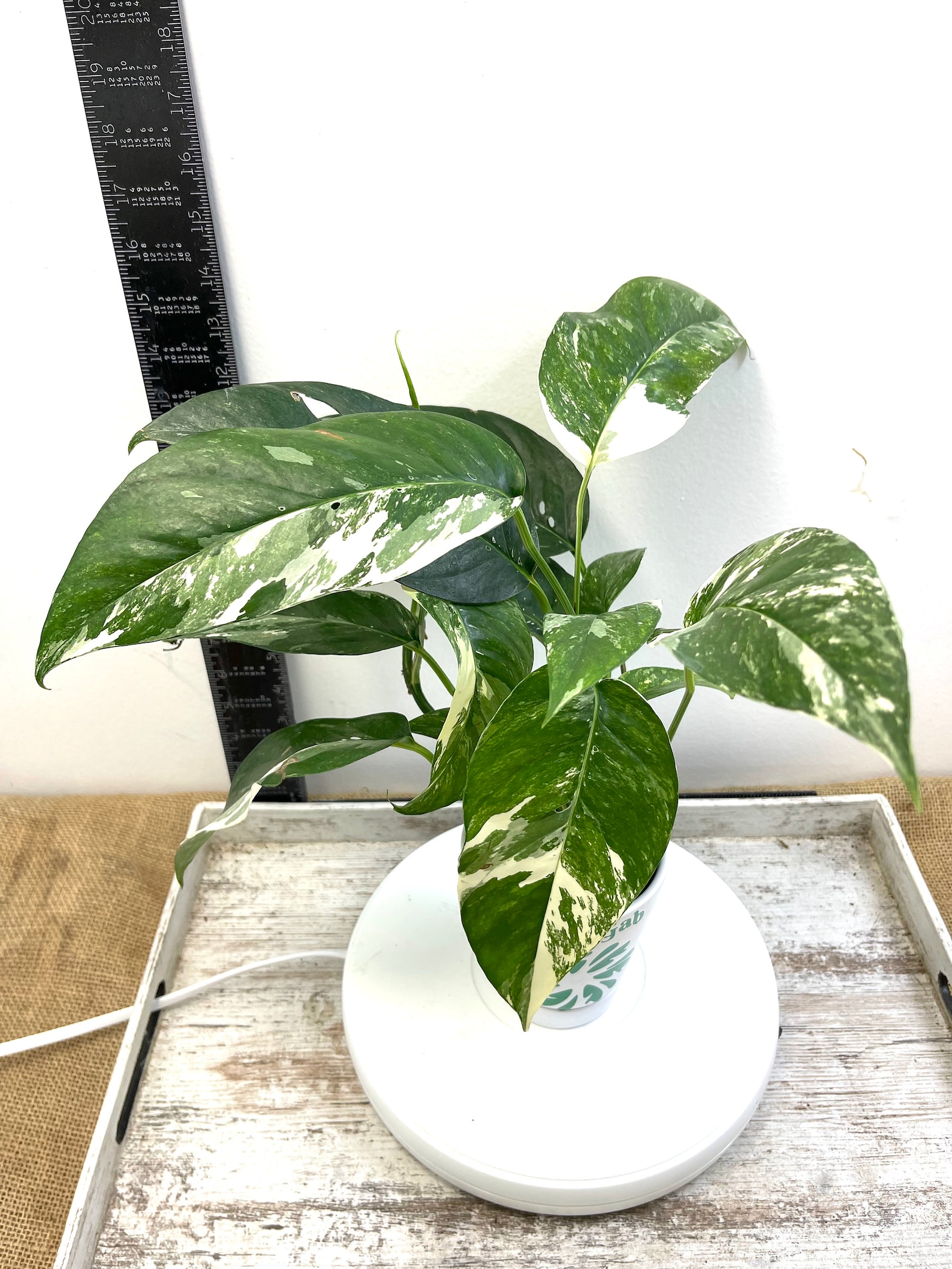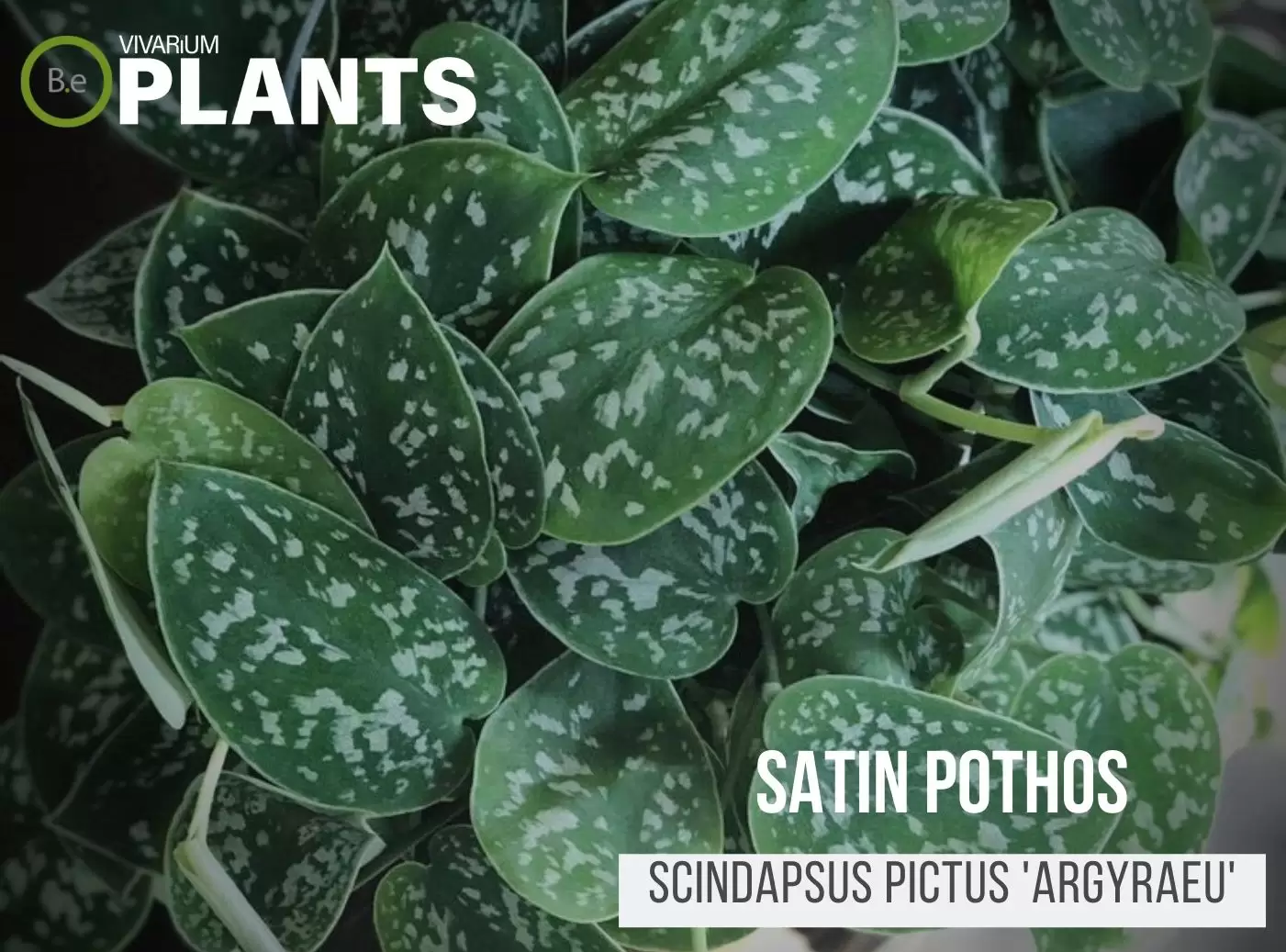Epipremnum pinnatum, or Cebu Blue Pothos, is an awesome tropical terrarium plant that makes a wonderful addition to any enclosure with or without animals.
Cebu Blue Pothos is an aroid plant meaning it can handle a range of environments and is safe for pets.
With the right environment, Cebu Blue Pothos can grow up and around your vivarium scape quickly giving it that tropical jungle looks you want.
It’s a very responsive plant and will show you when it’s not happy by drooping or wilting.
Quick Stats:
Scientific Name: Epipremnum pinnatum
Family: Araceae
Common Names: Dragon Tail Plant, Cebu Blue Pothos
Habitat: Jungle
Height: Up to 5ft
pH Range: 5.5 to 7.0
Temperature: 65°F to 85°F
Lighting: Bright
What Is Cebu Blue Pothos?
Epipremnum pinnatum is an evergreen, perennial vine With long trailing stems with heart-shaped, slightly wavy leaves.
The foliage of this plant generally has a yellowish-to-white variegation with streaks of light green. Taller stems have aerial roots and may reach up to 5 feet in length.
The leaves measure around 5 to 10 cm wide and look transparent when held against the light.


Cebu Blue Pothos Facts
Epipremnum pinnatum is a swiftly growing plant. Because of its fast growth, it is able to thrive in many different environments.
This plant is not only stunning to look at, but it’s also easy to maintain.
The Cebu Blue Pothos, being a climbing vine plant, is also great for enclosures with lizards or even arboreal animals as it helps to keep your animals from escaping.
Description
The Cebu Blue Pothos is a rather unkempt-looking beauty due to its sprawling stems and its horizontal growth pattern.
It has heart-shaped, lightly wavy leaves, with white variegation present on the top. The leaves are around 5 to 10 cm wide, making it a suitable plant for planting in the mid and background layers of a vivarium.
The stems can reach up to 5 feet in length and have aerial roots that cling to any surfaces they traverse.
Habitat
This plant is native to the tropical jungles of Southeast Asia and can be found growing in the forests and on tree branches of the region.
It prefers warmer temperatures, a humid environment, and bright indirect light. In its natural home, Cebu Blue Pothos will typically bloom in the spring months.
pH Preference
Cebu Blue Pothos prefers very neutral to slightly acidic soils. The ideal pH level for this plant is 5.5 to 7.0.
If the pH level is too far on either side of this range, it will likely not survive and likely die.
Vivarium Type
Just like most pothos, Cebu Blue Pothos can do very well in a variety of vivarium types. Although there is no determined enclosure that it must be placed in, some might be better than others.
The amount of space available is one of the most important things to keep in mind when making a decision.
In addition, Epipremnum pinnatum should also be provided with tropical, moist, and well-drained terrain areas. Here are recommended vivariums it will do well in:
-
- Paludariums – Half aquatic/ half terrain-based enclosure.
-
- Terrariums – Fully terrain-based enclosures with little to no aquatic features.
Vivarium Placement
This plant does best being placed in the background of a vivarium—not in direct lighting since that can cause the variegation to be washed away.
Instead of allowing it to trail, use a mesh screen or rope to contain the height of the plant. If you want it to grow taller, you can use a trellis or pole.
Substrate
Cebu Blue Pothos prefers the terrarium soil to have a loamy texture or even uses a coco coir.
Since this plant is very responsive and will wilt or drop its leaves if the soil stays soggy for too long, looser soils are more recommended.
Lighting
Cebu Blue Pothos prefers bright indirect light. A south-facing window in an existing vivarium would work as a great light source.
Also, it can tolerate a little bit of direct sunlight, but too much can burn or discolor the plant.
A suspended LED or fluorescent light with a broad spectrum and at least 8000 lumens is a great terrarium light source that will promote the healthy growth of the Dragon Tail Plant.
Buy Cebu Blue Pothos
When shopping for Cebu Blue Pothos, expect a few key indicators you are buying the best quality plant. The plant should be insect free along with any other types of pests.
Try to avoid any browning or wilting leaves. Those are usually signs of poor health and could make it harder for the plant to survive.
Click the image below to find out more about the current price and other relative info about this plant:
Cebu Blue Pothos Care & Propagation
One of the main benefits of the Cebu Blue Pothos is its easy propagation.
Stem cuttings can be placed in water then transferred to a soil mixture and grouped together to form a female cluster.
It can also be propagated by dividing the plant and repotting it.
How To Grow
Cebu Blue Pothos will grow well in either a pot or a vivarium. The root system of this plant needs to stay in loose soil, but it can climb on surfaces as well.
If grown in a vivarium, it can be trained to wrap around edges or to create a thicker, more lush plant.
To create a bushier Dragon Tail Plant, you can pinch off newly grown stems.
Watering
It is important to not neglect to water this plant. You want the soil to stay consistently moist.
For the best results, try to water the plant at least twice a week with a spray bottle and let the soil dry out slightly before watering again.
You will be able to tell if your plant needs its water as its leaves will start to droop.
Plants Similar To Cebu Blue Pothos
Adding diversity to an enclosure is key to an aesthetically pleasing setup. Try mixing up the look of your vivarium with different flora that can easily co-exist in the same types of environment.
Furthermore, if for some reason you find this pothos hard to acquire or would like to consider something similar to this plant…
Here are some other vine plants you might find may do well with or in the place of Cebu Blue Pothos:
Conclusion
Overall, I believe the Cebu Blue Pothos is a great low-maintenance plant for any vivarium.
Its ability to tolerate a variety of conditions and its easy propagation process make it a great plant to have in any vivarium, regardless of size.
It’s also an excellent choice for those who are just beginning their journey in the vivarium world!
Frequently Asked Questions
Yes, Epipremnum pinnatum is a type of pothos plant.
Cebu Blue is less commonly seen and can be harder to find due to its popularity.
No, Epipremnum pinnatum is not a Monstera. It is a species of climbing plant in the family Araceae commonly referred to as a pothos.
Yes, Epipremnum pinnatum (cebu blue pothos) is a fast–growing plant.
No, Epipremnum pinnatum cannot take direct sunlight as it prefers indirect, filtered light.
Yes, you can grow Epipremnum pinnatum (Cebu Blue Pothos) in water. It is a great way to propagate plants, as the cuttings will quickly root in the water and turn into healthy, mature plants. With this method, it is important to use clean, filtered water and to change it every 2–3 weeks.
Cebu Blue pothos is a rare, vibrant variety of pothos with striking coloration of deep blue–green leaves highlighted with silver streaks. Characterized by its easy–to–care–for nature, Cebu Blue pothos is an ideal choice for vivariums and provides a pop of color to any space. Its glossy, leathery leaves are highly sought after and make a beautiful addition to any home or office.
Average Maturing Time for Cebu Blue Pothos: 6–12 Months
Yes, misting Cebu Blue Pothos plants is recommended in order to ensure adequate humidity levels that will keep the plant healthy and thriving.




